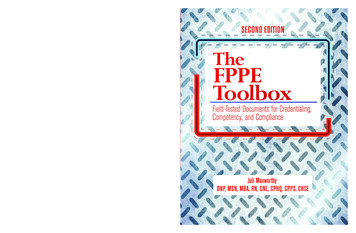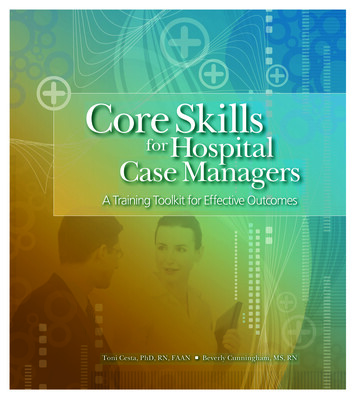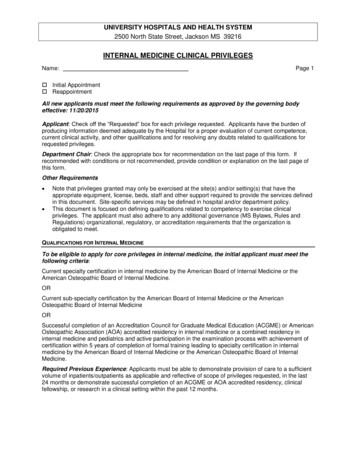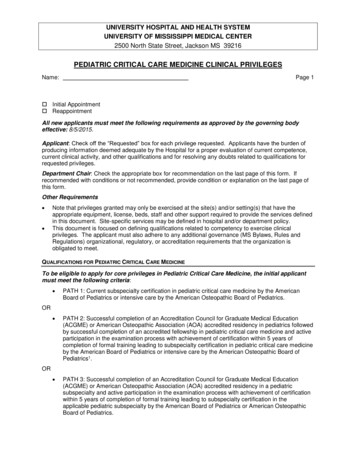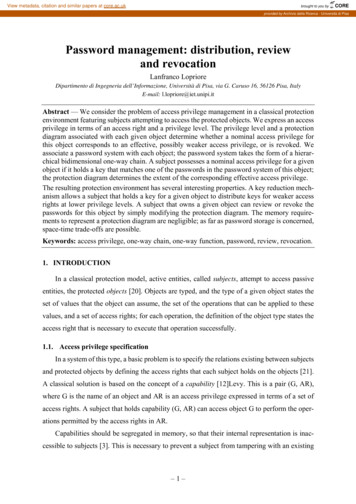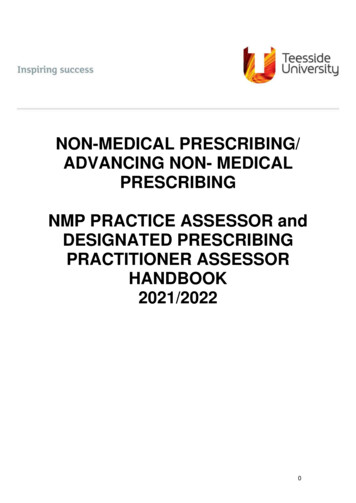
Transcription
CorePrivilegesAHPsforDevelop and Implement Criteria-BasedPrivileging for Nonphysician PractitionersThird EditionSally Pelletier, CPMSM, CPCSContributors:Carol S. Cairns, CPMSM, CPCSMary J. Hoppa, MD, MBAAmy Niehaus, CPMSM, CPCS, MBA27679 CPAHP3 EB321271.indd 11/19/15 2:54 PM
CorePrivilegesAHPsforDevelop and Implement Criteria-BasedPrivileging for Nonphysician PractitionersThird EditionSally Pelletier, CPMSM, CPCSContributors:Carol S. Cairns, CPMSM, CPCSMary J. Hoppa, MD, MBAAmy Niehaus, CPMSM, CPCS, MBA
Core Privileges for AHPs, Third Edition, is published by HCPro, a division of BLRCopyright 2015 HCPro, a division of BLRAll rights reserved. Printed in the United States of America.5 4 3 2 1ISBN: 978-1-55645-292-5No part of this publication may be reproduced, in any form or by any means, without prior writtenconsent of HCPro, or the Copyright Clearance Center (978-750-8400). Please notify us immediately if youhave received an unauthorized copy.HCPro provides information resources for the healthcare industry.HCPro is not affiliated in any way with The Joint Commission, which owns the JCAHO and Joint Commission trademarks.Sally J. Pelletier, CPMSM, CPCS, AuthorCarol Cairns, CPMSM, CPCS, ContributorMary Hoppa, MD, MBA, ContributorAmy Niehaus, CPMSM, CPCS, ContributorMary Stevens, EditorAdrienne Trivers, Product ManagerErin Callahan, Senior Director, ProductElizabeth Petersen, Vice PresidentMatt Sharpe, Production SupervisorVincent Skyers, Design Services DirectorVicki McMahan, Sr. Graphic DesignerJason Gregory, Layout/Graphic DesignKaren Christner, Cover DesignerAdvice given is general. Readers should consult professional counsel for specific legal, ethical, or clinicalquestions.Arrangements can be made for quantity discounts. For more information, contact:HCPro75 Sylvan Street, Suite A-101Danvers, MA 01923Telephone: 800-650-6787 or 781-639-1872Fax: 800-785-9212Email: customerservice@hcpro.comVisitHCPro online at: www.hcpro.com and www.hcmarketplace.com
Table of ContentsAbout the Authors. viiIntroduction. xiSample Policy & Procedure for Expansion (“Train Up”) of Privileges forAdvanced Practice Professionals (APP). xviSection 1: Clinical Privileges for Advanced Practice Nurses. 11. Certified Nurse-Midwife Clinical Privileges. 32. Certified Registered Nurse Anesthetist Clinical Privileges. 133. Clinical Nurse Specialist Psychiatric/Mental Health Clinical Privileges. 214. Nurse Practitioner Clinical Privileges—Acute Care. 275. Nurse Practitioner Clinical Privileges—Cardiovascular Medicine. 366. Nurse Practitioner Clinical Privileges—Cardiovascular Surgery. 497. Nurse Practitioner Clinical Privileges—Critical Care. 618. Nurse Practitioner Clinical Privileges—Dermatology. 719. Nurse Practitioner Clinical Privileges—Emergency Medicine. 7910. Nurse Practitioner Clinical Privileges—Neonatology. 91 2015 HCProCore Privileges for AHPs, Third Edition iii
Table of Contents11. Nurse Practitioner Clinical Privileges—Nephrology.10112. Nurse Practitioner Clinical Privileges—Neurology.10713. Nurse Practitioner Clinical Privileges—Orthopedic Surgery. 11514. Nurse Practitioner Clinical Privileges—Pediatrics. 12515. Nurse Practitioner Clinical Privileges—Primary Care. 13316. Nurse Practitioner Clinical Privileges—Psychiatric/Mental Health. 13917. Nurse Practitioner Clinical Privileges—Surgical.14518. Nurse Practitioner Clinical Privileges—Women’s Health. 155Section 2: Clinical Privileges for Physician Assistants. 16519. Physician Assistant Clinical Privileges—Acute Care. 16720. Physician Assistant Clinical Privileges—Cardiovascular Medicine. 17521. Physician Assistant Clinical Privileges—Cardiovascular Surgery. 18722. Physician Assistant Clinical Privileges—Critical Care.20123. Physician Assistant Clinical Privileges—Dermatology.21124. Physician Assistant Clinical Privileges—Emergency Medicine.21925. Physician Assistant Clinical Privileges—Nephrology. 23126. Physician Assistant Clinical Privileges—Neurosurgery. 23727. Physician Assistant Clinical Privileges—Orthopedic Surgery. 24928. Physician Assistant Clinical Privileges—Pediatrics. 25929. Physician Assistant Clinical Privileges—Primary Care. 26530. Physician Assistant Clinical Privileges—Radiology. 27131. Physician Assistant Clinical Privileges—Surgical. 28132. Physician Assistant Clinical Privileges—Urology. 29133. Physician Assistant Clinical Privileges—Women’s Health . 299iv Core Privileges for AHPs, Third Edition 2015 HCPro
Table of ContentsSection 3: Clinical Privileges for Other Non-physician Healthcare Professionals. 30734. Anesthesiologist Assistant Clinical Privileges. 30935. Clinical Psychologist Clinical Privileges. 31536. Pathologists’ Assistant Clinical Privileges. 32337. Radiologist Assistant Clinical Privileges. 32938. Registered Nurse First Assistant Clinical Privileges . 337Addendum—Certification Organizations for Advanced Practice Nurses and PhysicianAssistants. 343 2015 HCProCore Privileges for AHPs, Third Edition v
About the AuthorsSally Pelletier, CPMSM, CPCSSally Pelletier, CPMSM, CPCS, is an Advisory Consultant and the ChiefCredentialing Officer for The Greeley Company, Inc., in Danvers, Massachusetts. She brings more than 20 years of credentialing and privilegingexperience to her work with medical staff leaders and medical servicesprofessionals across the nation.Pelletier advises clients in the areas of accreditation, regulatory compliance, credentialing, privileging, onboarding process simplification andredesign, and medical staff services department operations, and providesleadership and development training for medical staff leaders and MSPs.She currently serves on the Editorial Advisory Board of the Credentialing Resource Center Journal andMedical Staff Briefing for HCPro, Inc., a division of BLR, in Danvers, Massachusetts. Pelletier serves asan expert witness, presents at state and national seminars on a variety of topics related to medical staffleadership training, leading practices in credentialing and privileging, and practitioner competencymanagement, and is faculty for The Greeley Institute for Medical Services Professional Development.She has coauthored several HCPro/Greeley books, including The Medical Staff’s Guide to Overcoming Competence Assessment Challenges (2013), Core Privileges for Physicians: A Practical Approach toDeveloping and Implementing Criteria-Based Privileges, Sixth Edition (2014), Assessing the Competencyof Low-Volume Practitioners: Tools and Strategies for OPPE & FPPE Compliance, Second Edition (2009),The FPPE Toolbox: Field-Tested Documents for Credentialing, Competency, and Compliance (2008), andConverting to Core Privileging: 10 Essential Steps to a Criteria-Based Program (2007). 2015 HCProCore Privileges for AHPs, Third Edition vii
About the AuthorsPelletier has served as secretary and as the Northeast region representative on the board of directorsfor the National Association Medical Staff Services (NAMSS). Other leadership roles for NAMSS haveincluded serving as a NAMSS instructor; and chairing the Governance, Management, and ManpowerCommittee, the Bylaws Committee, and the Credentialing Elements Task Force. In addition, she servedas president of the New Hampshire Association Medical Staff Services, from which she received the2008 Excellence in Medical Staff Services Award. Pelletier began her career in 1992 as the medical staffcoordinator at The Memorial Hospital in North Conway, New Hampshire.ContributorCarol Cairns, CPMSM, CPCSCarol Cairns, CPMSM, CPCS, has been in the unique position of seeingand participating in the development of the medical staff services profession for more than 45 years. In 1996, she founded Plainfield, Illinois-basedPRO-CON, a consulting firm specializing in credentialing, privileging,medical staff organization operations, and survey preparation.Cairns has counseled a variety of healthcare organizations on medicalstaff structure, bylaws content and revision, credentialing practices andprocedures, privileging systems, medical staff law, allied health credentialing, medical staff leadershipdevelopment, Joint Commission survey preparation, medical staff office operations, role and creation ofa credentials verification organization, etc. A recognized expert in the field, Cairns is a frequent presenterat healthcare entities as well as state and national seminars.In 1991, Cairns became clinical faculty for The Joint Commission by collaborating in the developmentof an educational program on credentialing and privileging medical staff and allied health professionals. She served as faculty for this program from 1991 through 2000. During that time, she coauthoredtwo books published by The Joint Commission that focused on the medical staff credentialing andprivileging standards.Cairns, a faculty member of NAMSS since 1990, has presented at numerous state and national conferences. She coauthored the initial NAMSS educational program for certification of provider credentialing specialists (CPCS) and the Credentials 101 seminar, and is faculty for both programs.In 1998, Cairns also began consulting and presenting with The Greeley Company. As senior consultant, she serves as an information resource for HCPro, and serves on the Editorial Advisory Boardof the Credentialing Resource Center Journal. She has written all six editions of Verify and Comply:A Quick Reference Guide to Credentialing Standards, and served as a co-author of the third and fiftheditions of Core Privileges for Physicians: A Practical Approach to Developing and Implementing Criteria-Based Forms. She has authored multiple books on credentialing allied health professionals (AHP),viii Core Privileges for AHPs, Third Edition 2015 HCPro
About the Authorsamong them A Guide to AHP Credentialing and Solving the AHP Conundrum: How to Comply with HRStandards Related to Nonprivileged Practitioners.Cairns also coauthored The FPPE Toolbox and The Medical Staff’s Guide to Overcoming CompetenceAssessment Challenges. In fall 2013, The Greeley Company recognized her professional contributionsby establishing the Aspire Higher scholarship. The scholarship is managed by NAMSS and presentedannually.From 1996-2006, Cairns served the National Committee on Quality Assurance (NCQA) as a surveyor inthe certification program for credentials verification organizations. During that time, she also presented programs as an NCQA faculty member on CVO Certification and the NCQA credentialing standards.For the past 18 years, Cairns has been an advisor to healthcare attorneys, including providing expertwitness testimony regarding credentialing and privileging issues. She was also invited by the AmericanOsteopathic Association to provide input into the development of the medical staff and AHP standardsfor the 2005 Healthcare Facilities Accreditation Program Manual. In 2005, the Illinois Association Medical Staff Services presented Cairns with a Distinguished Member award.Cairns’ career in medical staff services began in Joliet, Illinois, where she coordinated and directedmedical staff services for two healthcare organizations (Presence Saint Joseph Medical Center andSilver Cross Hospital). Among her areas of responsibilities were credentialing, privileging, meetingmanagement, quality improvement activities, medical staff orientation, and CME programming, aswell as serving as a liaison between medical staff and hospital administration and directors. In 2010,Cairns “returned to the beginning” by accepting an appointment to the Board of Directors Bylaws andCredentialing Committee of Presence Saint Joseph Medical Center.ContributorMary J. Hoppa, MD, MBAMary J. Hoppa, MD, MBA, is a senior consultant with The GreeleyCompany. She brings more than 25 years of healthcare leadership andmanagement experience to her work with physicians, hospitals, andhealthcare organizations across the country. Her roles in hospital administration and medical staff leadership in academic and communityhospital settings make her uniquely qualified to assist physicians andmedical centers in developing effective solutions to their most significantchallenges. She has experience in credentialing and privileging, peer review and quality, medical staffeducation, and conflict resolution, and is the leader of The Greeley Company’s bylaws division. Shebrings this experience into the accreditation practice. 2015 HCProCore Privileges for AHPs, Third Edition ix
About the AuthorsDr. Hoppa is one of The Greeley Company’s leading national speakers and is the author or coauthor ofthe following HCPro/Greeley books: The Guide to Medical Staff Bylaws (2014), The Medical ExecutiveCommittee Manual, Third Edition (2013), Engage and Align the Medical Staff and Hospital Management (2010), and The Medical Staff Leaders’ Practical Guide, Sixth Edition (2007).Dr. Hoppa is a family physician with more than 15 years of post-residency practice experience, including chief medical officer at Methodist Hospital in Merrillville, Ind. Her previous positions include physician advisor, medical director of an employed physician group, medical director of various insuranceplans, and member of the Iowa Board of Medical Examiners.Dr. Hoppa is a graduate of the University of Wisconsin Medical School and School of Business. She received her residency training at the Mercy/St. Luke’s Family Practice Residency Program in Davenport,Iowa.ContributorAmy Niehaus, CPMSM, CPCS, MBAAmy Niehaus, CPMSM, CPCS, MBA, is a consultant with The GreeleyCompany. She has more than 25 years’ experience in the medical services and credentialing profession and has worked in multiple environments throughout her career, including acute care hospitals, credentialsverification offices (CVO), and managed care organizations. In hercurrent role, Niehaus advises clients in the areas of accreditation, regulatory compliance, credentialing, process simplification and redesign, CVOdevelopment, credentialing technology and delegation.Niehaus has been a member of NAMSS since 1991 and achieved her CPMSM certification in 1992and CPCS certification in 2002. She has been a NAMSS Instructor since 2010 and previously served asChair of its Managed Care Organization Task Force, as well as Chair and Member of the NAMSS Education Committee. She is a former president of the Missouri Association Medical Staff Services and itsGreater St. Louis Area chapter.x Core Privileges for AHPs, Third Edition 2015 HCPro
IntroductionThe privileging of non-physician healthcare professionals1 poses challenges that differ from those encountered when privileging physicians. Before an organization can focus on credentialing and privileging these types of practitioners, it is essential to have a broad understanding of the issues related tothe various disciplines of non-physician healthcare professionals.Over the years, the following have emerged as trouble spots or stumbling blocks in this area: The lack of a clear definition of the types of practitioners who require privileging The wide range of clinical scopes defined by healthcare organizations Varying and unclear licensure requirements from state to state An increasing number of physicians employing non-physician healthcare practitioners for clinical assistanceUnderstanding recent and ongoing changes in healthcare will also help organizations chart futurecourses for utilizing these practitioners.The importance of identifying applicable state statutes for all non-physician healthcare professionalscannot be overemphasized. It is paramount that organizations understand the difference between whatscope of practice is permitted by the state licensing organization and what clinical privileges will bepermitted by the healthcare facility.1Organizations may also categorize this group of practitioners as allied health professionals or practitioners. Non-physician healthcareprofessionals include advanced practice professionals, e.g., advanced practice nurses, physician assistants, radiology assistants,anesthesiology assistants, and pathology assistants performing a medical level of care, as well as other disciplines such as registered nursefirst assistants, surgical assistants, and surgical technicians who perform invasive surgical tasks under a defined degree of supervisionand are required by CMS’ Conditions of Participation to be granted clinical privileges. 2015 HCProCore Privileges for AHPs, Third Edition xi
IntroductionIn recent years, many pieces of state and federal legislation have been introduced for non-physicianhealthcare professionals, particularly advanced practice professionals (APP), that propose: Expansion of their scopes of practice Extending the level of their clinical independence Entitling more categories to direct reimbursementMany of these efforts have been successful. For example, the number of states allowing nursepractitioners (NP) to practice independently is increasing every year.The changing services provided by healthcare organizations have also affected non-physicianhealthcare professionals’ credentialing. These changes have prompted extended utilization in a varietyof settings that are no longer solely within the domain of the acute care facility. Increasing numbers ofphysicians are recognizing the benefits to be gained by allowing an expansion of scope for APPs andare approaching healthcare organizations, seeking approval for them to provide additional serviceswithin that setting.Sources Used to Develop the Core Privilege FormsEach non-physician healthcare professional discipline has been researched from the aspects of statelicensing requirements, statements of professional organizations, required education and training,general supervision requirements, and a general overview of the description of the profession.Organizations can use the sample privilege delineation forms to tailor their own privilegingrequirements to each discipline.The privilege delineation forms outline the qualifications and potential clinical practice for each ofthe disciplines, including anesthesiologist assistants, pathologists’ assistants, radiologist assistants,psychologists, certified nurse midwives, NPs, certified registered nurse anesthetists, clinical nursespecialists, registered nurse first assistants, and physician assistants (PA). Because many of thedisciplines have become subspecialized, there are sample forms for NPs and PAs in subspecialtydisciplines, such as orthopedics, women’s health, acute care, psychiatric and mental health, etc. Ashealthcare organizations seek to define the level of care they want to permit, they will find these formsto be valuable tools.We have included references to various types of certifications available for advanced practice nursesand PAs as applicable on the core privileging forms. However, just as healthcare organizations andmedical staffs need to make their own decision related to the requirements for specialty-specific boardcertification for physicians, organizations must also consider whether they will require specialty- orxii Core Privileges for AHPs, Third Edition 2015 HCPro
Introductionsubspecialty-specific certification for advanced practice nurses and PAs. (See Addendum—CertificationOrganizations for Advanced Practice Nurses and Physician Assistants, Page 343.)Customizing the Core Privilege FormsAccording to CMS, delineation of clinical privileges must be hospital-specific. Therefore, whendeveloping your core privileging system, list only the services and procedures that your hospitalcurrently provides, e.g., an activity/task/procedure that the hospital can support and is conductedwithin the hospital. Do not include services and procedures that your hospital might offer in thefuture—the forms will not be hospital-specific if they contain services that the hospital does notcurrently provide.It is increasingly imperative for organizations to fully understand the nuances associated withstatutory and regulatory requirements for NP and PA practice. Some state laws describe the scope in arather perfunctory manner while other states are a great deal more specific about not only the definedscope of practice but also (particularly in the case of NPs) the specific education, training, and/orcertification required to perform the scope of practice. In Texas, for example, the scope of practice ofcertain specialty areas for advanced practice nurses is to be defined by national professional specialtyorganizations or advanced practice nursing organizations that would be recognized by the Texas Boardof Nursing. Because state-specific requirements vary, organizations must research and incorporatestate-specific requirements for education and certification into privilege documents as applicable.Once your hospital adopts a policy governing the threshold or basic qualifications for eligibility toapply for privileges, it should develop a process for the medical staff to prepare specific criteria forevaluating privilege requests. For example, if your hospital requires physicians to have formal trainingfor a specialty area, the medical staff should decide which procedures and conditions should be listedwithin the specialty. The medical staff then should identify what constitutes acceptable training inthe specialty. The medical staff also should determine requirements for recent experience, such asdocumentation of the number and types of cases performed in the past 12 months or the minimumnumber of patients treated within the past 12 months.Throughout the document, you will see [n] used in place of a specific number of cases. Your hospitalshould define the minimum case/patient volume (the “[n]”) required to maintain clinical competenceas recommended by the applicable department chair and the medical executive committee and subjectto approval by the governing board.The presence of APPs in hospitals has grown exponentially during the past decade becausecollaborating and supervising physicians have realized the value of APPs and often seek to expandthe role of APPs. Furthermore, APPs seek to increase their knowledge and skill base and thus theirscope of practice. The impending physician shortage provides a third incentive for organizations to 2015 HCProCore Privileges for AHPs, Third Edition xiii
Introductioncreate mechanisms to expand privileges for APPs. This adds to the complexity of privileging for theseadditional privileges or procedures and requires that the appropriate structure or mechanism be putin place. Academic hospitals inherently have a framework in place for on-site education and training.However, in community hospitals, this is not typically the case.Therefore, the first step in this process must be that the healthcare organization’s leadership(governing body, senior administration, and medical staff) determines that its mission and culturewould support expansion of privileges for APPs through an on-site education and training program.One aspect of this decision would be to assure that the facility’s professional liability carrier wouldinclude this activity.Once the decision is made to move forward, the organization is now ready to determine the policyand procedures necessary to accomplish its goal. Because this is a complex issue, we have provided atemplate policy and procedure to address the expansion or “training up” of privileges for APPs. (SeePage xvi.)If your organization determines that training up for APPs under direct supervision is not going tooccur, then your privilege forms need to require that applicants’ training and experience must correlateto the requested privileges, and the eligibility route for direct supervision to allow for training up is notprovided.Procedure ListsThe core procedure lists attached to each of the relevant privilege forms provide examples of theprocedures that may be performed within a particular non-physician healthcare professional discipline.Please note that these lists are not all-inclusive but, rather, are a sampling of procedures that may fallunder a particular specialty.These lists also must be hospital-specific, as noted above. Each facility should review the privilegerequest forms and associated procedure lists and then modify the privilege request form by adding ordeleting procedures as necessary.Non-physician healthcare professionals in your facility might not perform all of these procedures orthey might perform additional procedures that are not listed in this book. Customize these lists tomatch the scope of your hospital services. Your chief of surgery, operating room scheduling supervisor,medical director of the endoscopy suite, and other clinical chiefs should assist in the review of theprocedure lists relevant to the specialty area of clinical practice. Many organizations have found thatthe expertise provided by an allied health credentials committee consisting of advanced practice nursesand physician assistants is extremely valuable.The medical executive committee (MEC) should oversee the process. Once the process is complete, theMEC will make its recommendation to the governing board.xiv Core Privileges for AHPs, Third Edition 2015 HCPro
IntroductionImportant DisclaimerThe sample core privileging forms that follow include a large amount of controversial information—particularly concerning the criteria for determining competence for specific specialties andprocedures. These forms should be considered sample drafts only—they are not specific or definitiverecommendations by the author.Before adopting these forms, carefully review and modify them to meet the specific needs andenvironment of your hospital or healthcare facility. The descriptions of the core, the specialprocedures, the procedure lists, and the criteria should all be customized to your organization. Theforms should be consistent with your organization’s current medical staff or health plan bylawprovisions governing the credentialing and privileging processes. Have the forms reviewed byknowledgeable legal counsel to ensure that they comply with relevant local, state, and federal lawsand regulations.All of the content within the forms should be reviewed and customized for your organization. We haveutilized [brackets] throughout the document to highlight areas of focused discussion and decision.For hospitals that have clinics operating under the provider number of the hospital, those clinics andthe practitioners working in those clinics need to be included in the medical staff privileging process.The content of the core forms provided in this book are primarily focused on the “traditional hospital”setting. Because there may be additional procedures or testing done in the clinic or ambulatoryenvironment for which the non-physician healthcare professional must be privileged, organizationsshould be aware of their responsibility to include all such clinical activities, whether they occur in thehospital or in the provider-based clinic.NOTE: The content of these forms delineates the concept of “training up” and allows organizations to identify the coreand the procedures that require direct supervision. Organizations that transition the content of these forms into anelectronic privileging module must ensure that this concept is accurately displayed within the software.
leadership training, leading practices in credentialing and privileging, and practitioner competency management, and is faculty for The Greeley Institute for Medical Services Professional Development. She has coauthored several HCPro/Greeley books, including . The Medical Staff's Guide to Overcom-ing Competence Assessment Challenges (2013),
